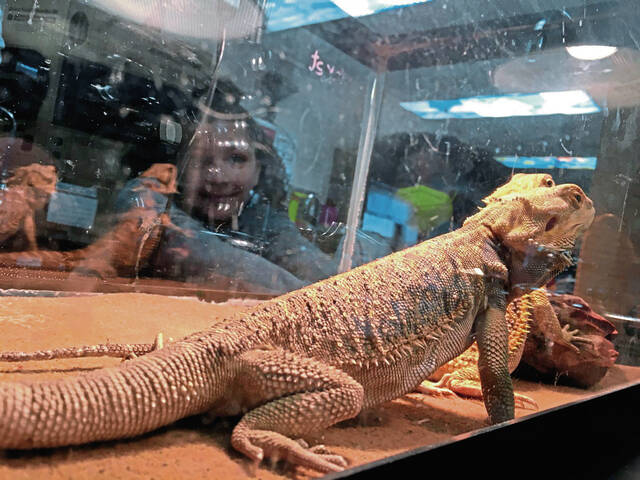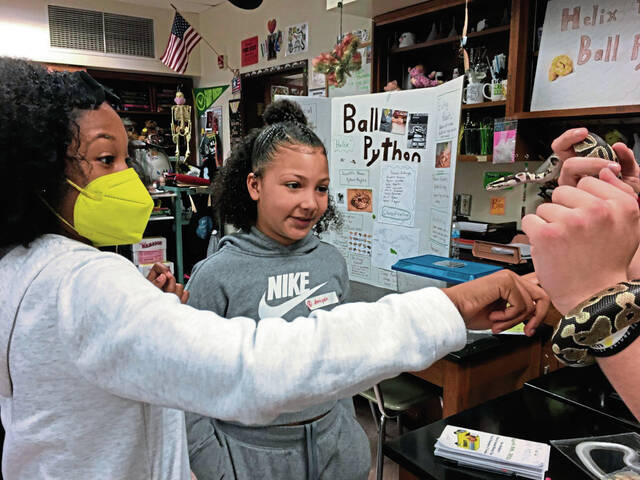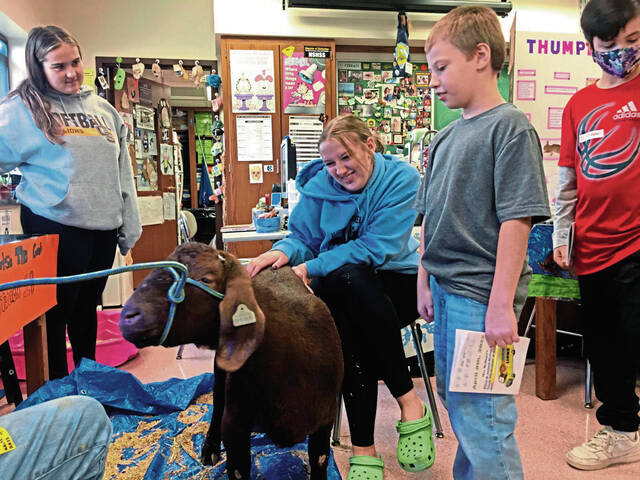Greensburg Salem High's Critter Cruise helps kids get to know diverse species
An albino axolotl piqued the curiosity of many a fourth-grader Friday as it rested enigmatically in its tank at Greensburg Salem High School.
A type of salamander that originated in Mexico, it was among 20 species of amphibians, reptiles, arachnids, insects, birds, fish and mammals displayed for fourth-graders from adjacent Nicely Elementary in Greensburg to look at — and sometimes touch — during the 12th annual Critter Cruise
The event was hosted by Andrea Redinger’s plant and animal biology class.
““It looks like it doesn’t have any eyes,” said Hope Lane, 10, among those fascinated by the salamander.
Lane also enjoyed seeing the different color patterns of fur sported by 5-month-old Theo and Tito, a pair of pet Dumbo rats.
“They’re like big hamsters,” she said.
The domesticated rats were displayed by owner Amber Matson of Salem, a senior at the high school.
While many adults have an aversion to rats, Matson noted a number of the Nicely students wanted to hold Theo and Tito.
“They’re very fun,” she said of the rodents. “They’re very social, and they love to be held.”
Nicely student Aniyah Hall, 10, noted a family member owns a crested gecko, one of the other animals featured at the high school.
But she took a fancy to a nearby coed pair of bearded dragon lizards, Watson and Cricket.
“They’re bigger, and they’re cute and funny,” she said.
Among the many exhibited critters owned by Redinger, the dragons were handled by junior Destiny Walker of Salem.
The lizards are native to Australia, Walker told the younger students, but she added, “They’re kind of everywhere because they’re pets now. You can walk them like a dog, with a leash and a harness.”
Walker explained the lizards have a pretty wide-ranging diet, but they have to stay away from oranges.
“The acid in the oranges messes with their stomachs,” she said.
Other species on display included a llama, a yellow-footed tortoise, a chocolate chip sea star, a ball python, a Kahki Campbell duck and Madagascar hissing cockroaches.
The event is a learning experience for both the elementary visitors and for Redinger’s students, who boned up on their assigned species so they could properly inform the younger kids about them.
“The best way to know if you really learned something is to teach it to someone else,” Redinger said. “The fourth-graders are always very appreciative, and I hear from the parents all the time about all the different things they learned while they were here.”
“I like to educate people, and I’ve always loved kids,” said Matson, who wants to go into the nursing field. “I want to better understand, myself, about science but also help other people understand it.”
Jeff Himler is a TribLive reporter covering Greater Latrobe, Ligonier Valley, Mt. Pleasant Area and Derry Area school districts and their communities. He also reports on transportation issues. A journalist for more than three decades, he enjoys delving into local history. He can be reached at jhimler@triblive.com.
Remove the ads from your TribLIVE reading experience but still support the journalists who create the content with TribLIVE Ad-Free.







